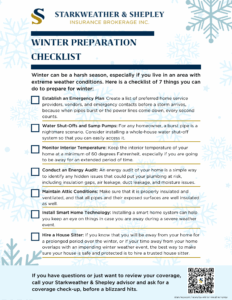
Blue and White Minimalist Winter Preparation Checklist
For those who live in the northern climates, the changing of the leaves and the crisp air that marks the onset of fall are a harbinger of the cold weather that lies ahead. This year, when Old Man Winter sets his sights on your region, be prepared. Whether your forecast is calling for an oncoming blizzard or a stretch of extremely cold temperatures, here are some tips on how you can prep your house to weather the storm.
There’s an old saying: plan for the worst, hope for the best. That philosophy certainly rings true for homeownership, especially when a storm is approaching. The best first step any homeowner can take to prepare themselves and their property for a potential weather-related event is to establish an emergency plan. Create a list of preferred service providers, vendors, and emergency contacts before a storm arrives, because when pipes burst or the power lines come down, every second counts. For any homeowner, a burst pipe is a nightmare scenario. Consider installing a whole-house water shut-off system so that you can easily access it. If a leak is detected, a water shut-off system can automatically turn off your water supply and notify you before significant damage can occur. Additionally, if your home’s basement is prone to flooding, then chances are your home has a sump pump (and if you don’t, it’s time to get one). When snow starts melting due to a rapid warming event, or the forecasted blizzard turns into a wintery mess of sleet and rain, your basement and crawl spaces may become flooded. Having a battery or water-powered backup power source for your sump pump can help. During the winter months, experts recommend keeping the interior temperature of your home at a minimum of 60 degrees Fahrenheit, especially if you are going to be away for an extended period of time. This will help to protect your pipes from freezing and bursting and help prevent other damage that may occur from prolonged exposure to extremely low temperatures.1. Establish an Emergency Plan
2. Water Shut-Offs and Sump Pumps
3. Monitor Interior Temperature
4. Conduct an Energy Audit
An energy audit of your home is a simple way to identify any hidden issues that could put your plumbing at risk, including insulation gaps, air leakage, duct leakage, and moisture issues. Most municipalities provide these services for free, just reach out to your energy provider and inquire.
5. Maintain Attic Conditions
If your home has an attic or crawlspace, make sure that it is properly insulated and ventilated, and that all pipes and their exposed surfaces are well insulated as well. This will help to reduce the chances of broken or frozen pipes. Additionally, make sure that you maintain a regular snow removal schedule in instances of extreme snowfall.
6. Install Smart Home Technology
Today, there are many technological options that homeowners can take advantage of to better monitor and control the conditions inside their homes. These include the ability to control the thermostat, security and video systems, lights, appliances, and more from smartphone or mobile device. Installing a smart home system can help you keep an eye on things in case you are away during a severe weather event..
7. Hire a House Sitter
If you know that you will be away from your home for a prolonged period over the winter, or if your time away from your home overlaps with an impending winter weather event, the best way to make sure your house is safe and protected is to hire a trusted house sitter. Daily check-ins during cold weather and winter storms will provide you with peace of mind while you’re away.
Still, have questions? Speak to one of our specialists today
and together, we can weather the storm.
We Make Reporting Your Claim Easy
- Contact us: info@starshep.com
- Late night trouble? Call our after-hours claims line: 800-446-5838
- Submit an online claim at your convenience, just click here.
- For auto glass-only claims, please report directly to the carrier.
Related posts

Hanover Theater Group Photo


